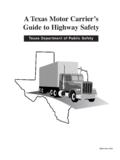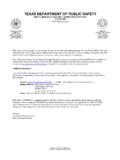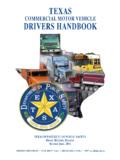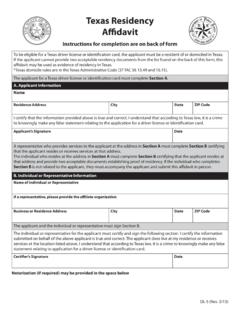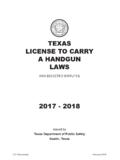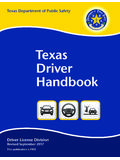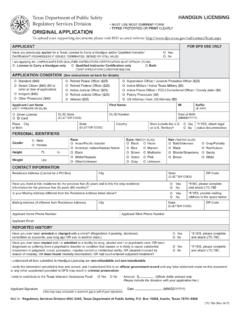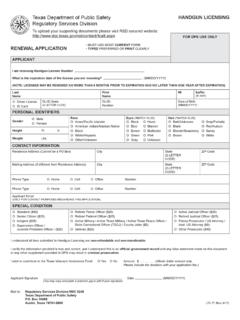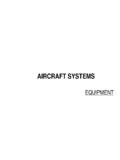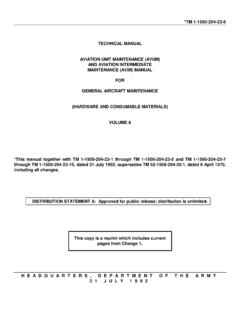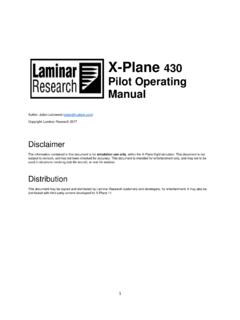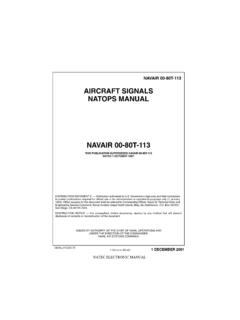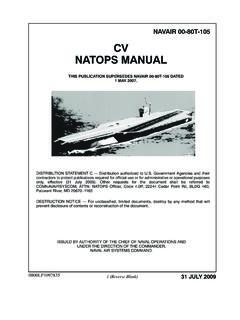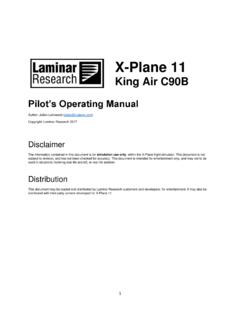Transcription of Unmanned Aircraft System (UAS) Standard …
1 Chapter 4, Annex #11 texas department OF public safety Unmanned Aircraft System (UAS) Standard operating Procedure September 1, 2019 Chapter 4, Annex #11 1 9/2018 Project Charter Version Control Version Date Author Change Description 06/20/2017 Bill Nabors Document created 06/29/2017 Bill Nabors Formalize descriptions and processes. 09/11/2017 Glen Stafford Added requirement for declaration of authorization under which flight is being conducted; , updated titles for Directors 10/04/2017 Bill Nabors Reorganized interactions of Division Directors, DPC, and AOD Chief Pilot 11/06/2017 Bill Nabors Formalized paragraph markings. 09/01/2019 Jason Day Added recurrency training and recertification requirements, grammatical edits, updated title for Chiefs and expanded accident notification. Chapter 4, Annex #11 2 9/2018 PREAMBLE The mission of the Small Unmanned Aircraft Systems (UAS) program is to provide aerial support and assistance to department personnel pursuant to their Division s mission and requirements.
2 UAS serve to augment DPS air operations and are excellent tools to deploy when department Aircraft are unavailable, if the mission is too dangerous for manned Aircraft to be deployed, or when deemed more cost effective than conventional Aircraft . Unmanned Aircraft shall be operated in a responsible manner consistent with department policy, texas State laws, and federal rules and regulations; ensuring that the privacy rights of the people in the State of texas are respected. This document will define the missions, training requirements, command relationships, standardization, specific flight team responsibilities and duties, and the reporting requirements to which department employees will adhere in order to operate and safely deploy Unmanned Aircraft . Chapter 4, Annex #11 3 9/2018 TABLE OF CONTENTS I. Purpose and Scope .. 4 II. 5 III. Organizational Definitions - Chain of Command Relationships and Flight Team Members .. 7 IV. 9 V. Emergency . 12 VI. Training and 15 VII.
3 Position Responsibility and Duties .. 18 VIII. Reporting Requirements .. 20 Chapter 4, Annex #11 4 9/2018 General Provisions I. Purpose and Scope A. This policy establishes the authorized use and operational guidelines for Unmanned Aircraft Systems (UAS) within the texas department of public safety . The UAS program is a function of the individual Divisions who are responsible for purchasing, maintaining, manning, operating and storing UAS, but with oversight advisory for compliance to regulations by the Aircraft Operations Division (AOD) Chief Pilot. B. This policy is designed to minimize risk to people, property, and Aircraft during the operation of the UAS while continuing to safeguard the right to privacy of all persons. It is further designed to keep the department and its personnel from being subject to the civil and criminal penalties for misuse of UAS and remain in compliance with the strict legislative reporting requirements. C. This policy is created to ensure that department employees who operate and deploy UAS are Remote Pilots in Command (RPIC) as defined in the Federal Aviation Administration (FAA) and have received training on the proper and safe operation of UAS.
4 D. This policy will define the training and certifications necessary to operate and deploy Unmanned Aircraft and will establish guidelines and best practices for RPICs to follow in order to safely deploy UAS assets. E. At all times the department and its personnel shall comply with 14 CFR Parts 107 and/or Certificate of Authorization, plus applicable portions of CFR 14 Parts 61 and 91; as well as texas Government Code 423 and 2205 F. If conflicts exist between FAA regulations, texas Government Code, texas Administrative Code and any part of this policy, the most restrictive will apply. Chapter 4, Annex #11 5 9/2018 II. Definitions A. Aircraft . A device that is used or intended to be used for flight in the air. This includes UAS. B. Airworthiness Statement. The Airworthiness of the UAS is self-certified by the Remote Pilot in Command through a preflight inspection prior to flight. C. Certificate of Authorization (COA). COA is an authorization issued by the Federal Aviation Administration (FAA) to a public operator for a UAS.
5 After a complete application is submitted, the FAA conducts an operational and technical review. If necessary, provisions or limitations may be imposed as part of the approval to ensure the UAS can operate safely with other airspace users. D. Crewmember. A person assigned to perform duty while an Aircraft is operating . E. Crew Resource Management (CRM). The effective use of all available resources including human, hardware, and information resources and coordination in the use of those resources by the RPIC, Remote Pilot and Visual Observer. F. First Person View (FPV). The Remote Pilot is observing the flight solely through the UAS camera. G. Flight time. Remote piloting flight time commences when an Aircraft moves under its own power for the purpose of flight and ends when the Aircraft comes to rest after landing. H. Image. Means any capturing of sound waves, thermal, infrared, ultraviolet, visible light, or other electromagnetic waves, odor, or other conditions existing on or about real property in this state or an individual located on that property.
6 Imagery may include data about people, organizations, events, incidents, or objects as well as metadata. I. Visual Line of Sight (VLOS). The Remote Pilot and/or the Visual Observer can see, unaided, the UAS under their control during flight. J. National Airspace System (NAS). Airspace inside the continental United States. It is further defined through air navigation facilities, equipment and services, airports or landing areas, aeronautical rules, regulations and procedures . There are two types of airspace within the NAS, controlled and uncontrolled. Operation of a UAS in controlled airspace adds another layer of responsibilities and requirements that must be met to operate the UAS. Chapter 4, Annex #11 6 9/2018 K. Night Flight. Flight of a UAS that occurs between the hours of one half hour after sunset and one half hour before sunrise. The time of sunset and sunrise are determined by the National Oceanic and Atmospheric Administration (NOAA), but 14 CFR Part 107 will allow small UAS operations to be conducted during civil twilight if the small Unmanned Aircraft has lighted anti-collision lighting visible for at least 3 statute miles.
7 The night time-operations prohibition in this rule is waivable through the FAA for Part 107 or as an addendum to approved certificate of waiver to the COA. L. Mission Area of Operations (AOR). A defined perimeter/parameters to be determined based on the scope and type of the operation and a defined operational ceiling at or below 400 feet above the ground. The altitude of the small Unmanned Aircraft cannot be higher than 400 feet above the ground, unless the small Unmanned Aircraft is flown within a 400 foot radius of a structure and does not fly higher than 400 feet above the structure s immediate uppermost limit. M. Unmanned Aircraft System (UAS). UAS is the Unmanned Aircraft System and all of the associated support equipment, control station, data links, telemetry, communications, and navigation equipment, etc., necessary to operate the Unmanned Aircraft . The Aircraft s flight is controlled either autonomously by hardware within the UAS or under the remote control of a Remote Pilot on the ground or in another ground vehicle.
8 For purposes of this program, the 14 CFR Part 107 compliant UAS shall weigh less than 55 pounds fully loaded. Maximum groundspeed is limited to 100 mph (87 knots). N. Visual Flight Rules (VFR). All flights with the UAS shall be conducted under VFR conditions and at an altitude below 400 AGL. VFR is established as a 3 mile visibility and a cloud ceiling of 1,000 feet for day operations and 5 mile visibility with a cloud ceiling of 2,000 feet for night operations. O. Aircraft Registration. All UAS operated by department personnel must be registered in accordance with current FAA 14 CFR Part 107 regulations. Registration requirements apply to UAS owned and operated by the department as well as UAS on loan or UAS owned by outside agencies when operated by a department RPIC. Chapter 4, Annex #11 7 9/2018 III. Organizational Definitions - Chain of Command Relationships and Flight Team Members A. AOD Chief Pilot will: 1. Establish protocols to prevent violations of policy, law, and public privacy; 2.
9 Be responsible for the department UAS reporting requirements under texas Government Code 423 and 2205; and 3. Review and approve a training curriculum to assess the knowledge, skills and abilities of RPICs and Visual Observers. B. Division Chiefs will: 1. Resolve conflicts or disputes that might arise related to policy or mission within their division; 2. Control the dissemination of any information produced by the divisions UAS team; 3. Designate the Division Program Coordinator C. Division Program Coordinator (DPC) will: 1. Be responsible for assisting in the tactical and administrative functions related to the UAS program within his/her Division; 2. Maintaining a current list of all certified crew members to include Remote Pilots and Visual Observers; 3. Maintaining the training records for crew members and compliance with texas Government Code 423 reporting requirements; 4. Be responsible for the condition, maintenance, and flight records of the UAS and its associated equipment within the data reporting software of DroneSense; and 5.
10 Be responsible for registration and markings of all UAS owned and operated by their division in accordance with current FAA 14 CFR Part 107 regulations. Chapter 4, Annex #11 8 9/2018 D. Flight team. Any combination of the RPIC, Remote Pilot or Visual Observer(s). ONLY the RPIC meets the FAA definition of crewmember. E. Remote Pilot. The individual exercising pilot at the controls over the UAS during flight. The Remote Pilot need not be 14 CFR 107 certified if the pilot is under the supervision of a RPIC who is in direct communication and in a position to take over control of the UAS, regardless of certification. Undesignated remote pilots may be student pilots at the controls. F. Remote Pilot in Command (RPIC). The mission commander with on-site authority for the UAS. The individual solely responsible for the overall flight operations for a specific mission. He/She may also act as either Remote Pilot or Visual Observer. Regardless, He/She may not delegate his/her responsibility.
